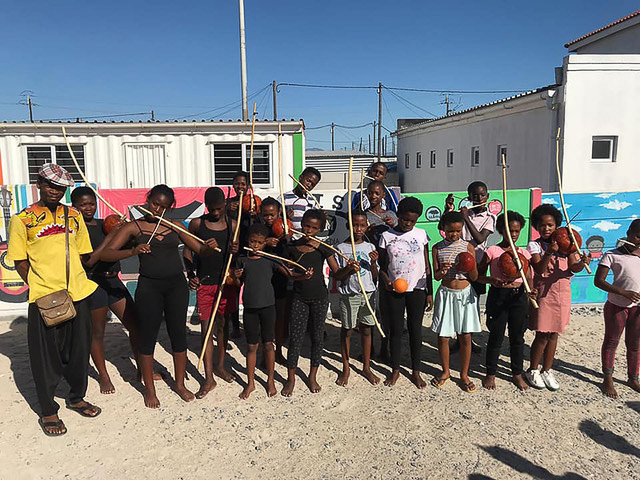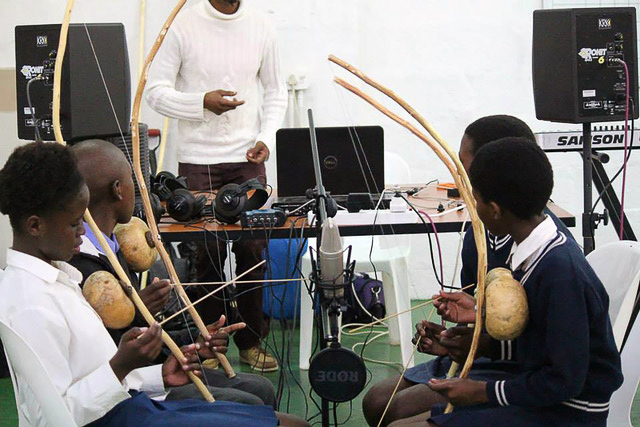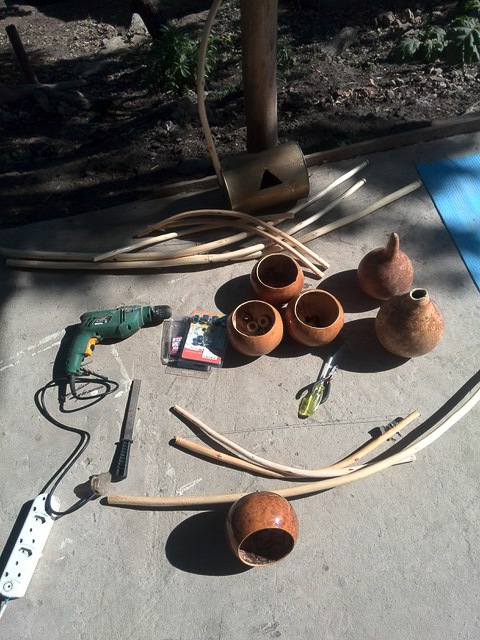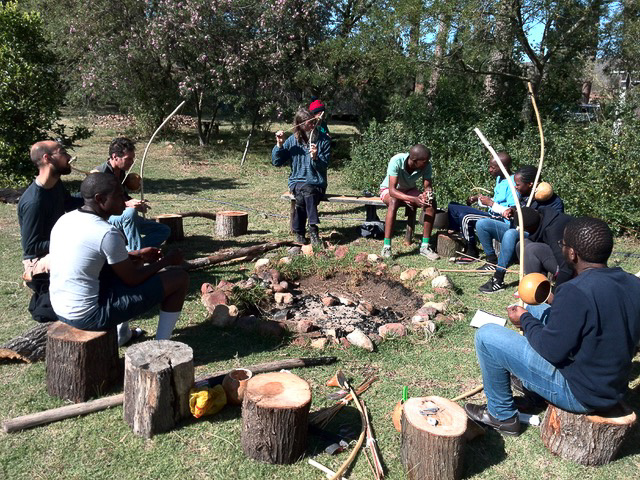Gary Warner begins a series #africamade_n_played with a Xhosa stringed instrument that resonates through the body and is taken up today by a new generation of performers.
An arc of wood held in tension by a single taut string is an ancient instrument form with diverse African expressions. Materials differ depending on locale. Bow wood is selected for specific qualities from local flora. The string might be plant fibre, twisted and polished animal hair, skin or gut and more recently wire. The playing bow or beater might be the stem of a particular grass, a thin stick, a strip of bamboo.
The instrument has captivating presence but is acoustic and quiet so is amplified through a resonator—the player’s mouth or a dried gourd. Even then, it is still an instrument and form of song that demands close listening, an attentive audience. Matombi Matotiyana remembers her early life when the instrument was only played by older women at night. The hubbub of village life would subdue to listen in complete darkness. The uhadi player would adjust her clothing to ensure the sound from the gourd resonator, rhythmically pressed against and reflected from the skin of her chest, would not be muffled by cloth.
Matombi Matotiyana, Latozi Mphahleni aka Madosini Manquina, Thankdeka Mfinyongo, Luyolo Lenga, Dizu Plaatjies. These are names of Xhosa and Mpondo makers and players of uhadi (with gourd) and umruhbe (without gourd). Internet searching provides many examples of each of them playing in diverse situations, from South African homes, halls and schools, to London clubs and music festival stages around the world.
Both uhadi and umruhbe generate two fundamental notes: one on the open untouched string and the other when the player presses the string to shorten the length. But the method of playing and type of sound from each instrument differ. The umruhbe string is bowed with a dried grass stem while the player holds the top of the wooden bow in their mouth. The string’s vibrations resonate in the mouth cavity, and the player modulates pitch by movements of tongue, lips and cheeks. A further haunting sound is added by using the breath to whistle-hum from the open sides of the mouth gripping the bow. The hypnotic rhythmelodic drone provides a bed for multipart singing by other women, in Xhosa often involving throaty overtones.
The uhadi sound is also dual rhythm and melody, but the player is free to sing as the string is repeatedly struck with a long thin, rigid fibre. The reverberant open note hangs in the air. The closed note is more percussive. The resonating chamber—a dried gourd fixed to the bow and cut open on the player side—is moved back and forth to create a wah-wah effect, complexify secondary harmonics and contribute to the rhythmic strength of the performance.
In traditional Xhosa and Mpondo life, these instruments were played by women for songs of place names, journeys and events, and topical songs about everyday life. Today, alongside famed women elders such as Matombi Matotiyana and Madosini Manquina, young women such as Thankdeka Mfinyongo and Nomapostile Nyiki and men such as Luyolo Lenga and Dizu Plaatjies make, play and promote the intrinsic cultural values and unique sonic and poetic appeal of these instruments. They carry them forward from their long tradition to keep people today connected with the crucial human experience of making instruments and playing, singing and listening to music and song together.
Videos
Luyolo Lenga – How to make the uhadi in 7 days – offered as a COVID19 project. 2020
Luyolo Lenga – How to play the uhadi. 2020
Wife and husband Mthwakazi & Luyolo Lenga perform on South African TV. 2016
Dizu Plaatjies explains the umruhbe at the UBUNTU Festival, Carnegie Hall. 2014
Dizu Plaatjies plays the uhadi – his instagram account. 2020
https://www.instagram.com/p/CAnMvS1AhCy/
Mantombi Matotiyana performing in Capetown. 2019
A Conversation between Mantombi Matotiyana and Dizu Plaatjies. 2019
Madosini & Thandeka Mfinyongo perform together in Capetown. 2018
Thandeka Mfinyongo performs at ALT BLK Continua. 2019
Thandeka Mfinyongo repost – archival video of Xhosa women singing in a kitchen. 1970s
https://www.instagram.com/p/B0QCAnzDb3r/
Author
 Gary Warner is an artist and art worker with a studio in Darlinghurst, Sydney and an off-grid bush retreat 50km north-west of there. In 1997 he started CDP Media, a cultural production company that has developed and delivered a wide variety of museum exhibition projects in collaboration with FRD and other designers, architects, artists and curators. His personal art practice spans various media including sound, video, drawing, installation and performance in contexts including writing, curating, collaboration, design, workshops and exhibitions. In 2016 he curated FIELDWORK: artist encounters at the Sydney College of the Arts and was commissioned by FRD to create a permanent multi-screen video installation for a new ceramics gallery at the Asian Civilisations Museum, Singapore. For more information, see garywarner.net, fieldwork.show and cdpmedia.com.au
Gary Warner is an artist and art worker with a studio in Darlinghurst, Sydney and an off-grid bush retreat 50km north-west of there. In 1997 he started CDP Media, a cultural production company that has developed and delivered a wide variety of museum exhibition projects in collaboration with FRD and other designers, architects, artists and curators. His personal art practice spans various media including sound, video, drawing, installation and performance in contexts including writing, curating, collaboration, design, workshops and exhibitions. In 2016 he curated FIELDWORK: artist encounters at the Sydney College of the Arts and was commissioned by FRD to create a permanent multi-screen video installation for a new ceramics gallery at the Asian Civilisations Museum, Singapore. For more information, see garywarner.net, fieldwork.show and cdpmedia.com.au







